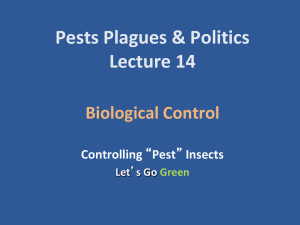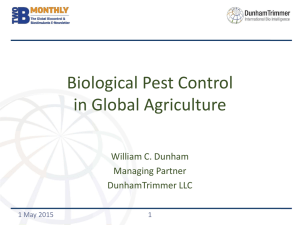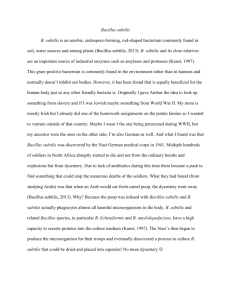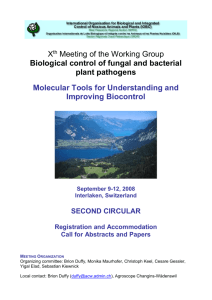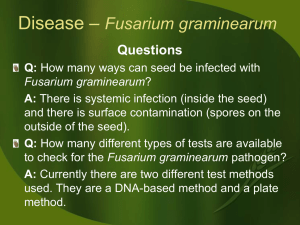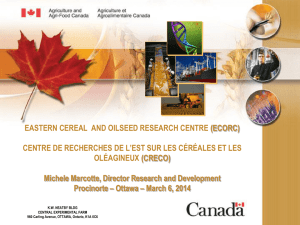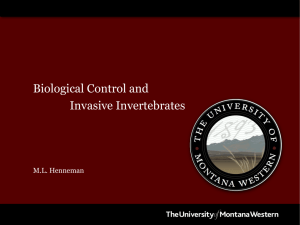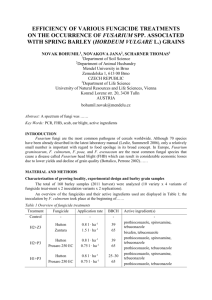Topic Proposal
advertisement
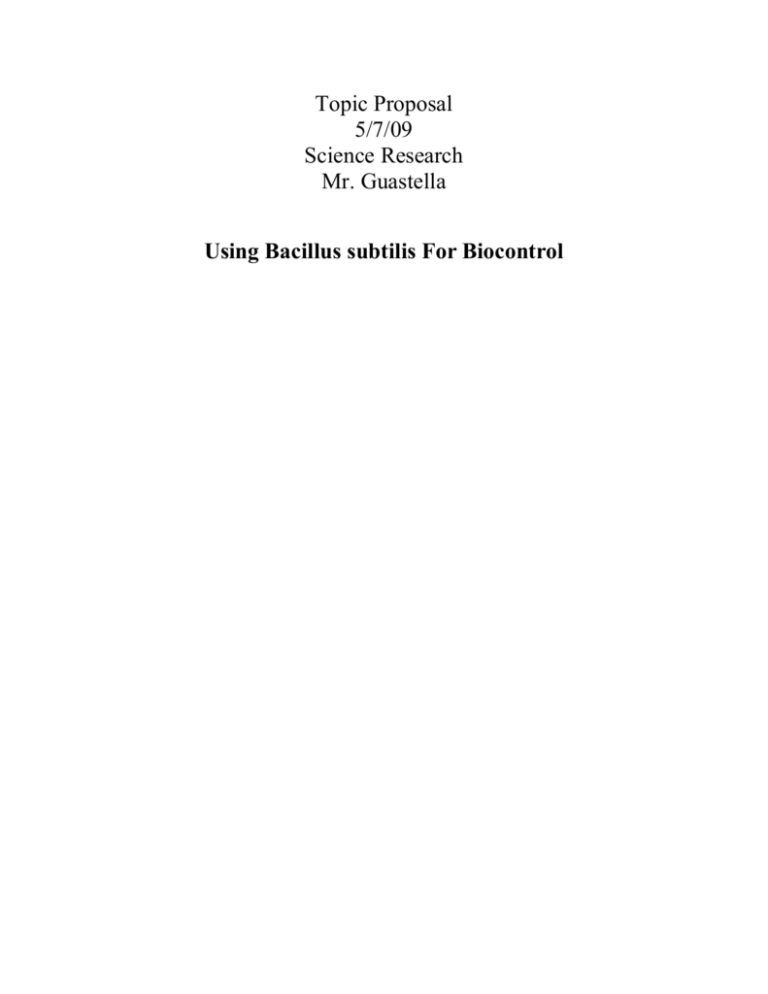
Topic Proposal 5/7/09 Science Research Mr. Guastella Using Bacillus subtilis For Biocontrol Losses from plant diseases also can have a significant economic impact, causing a reduction in income for crop producers and distributors and higher prices for consumers. In 1993 the United States lost more than one million acres (405,000 hectares) of crops to disease. More than 800,000 acres of wheat succumbed to disease, exacting a monetary loss in the millions of dollars. Another example of plant diseases were Irish famine which caused many deaths. And these plant diseases still cause economic problems in the societies. For a number of years, it has been known that various microorganisms exhibit biological activity so as to be useful to control plant diseases. Every year 250-300 million dollars of chemical pesticides are used to control corn rootworm infestations. Many of these chemical pesticides are toxic to humans, wildlife and other nontarget species. Also some have been found in the ground water. New chemical insecticides cost $100 million to develop. Biological control offers an attractive alternative to synthetic chemical fungicides. Biopesticides (living organisms and the naturally produced compounds produced by these organisms) can be safer, more biodegradable, and less expensive to develop. As used herein, "biological control" is defined as control of a pathogen or insect by the use of a second organism. Known mechanisms of biological control include enteric bacteria that control root rot by out-competing fungi for space on the surface of the root. Bacterial toxins, such as antibiotics, have been used to control pathogens. The toxin can be isolated and applied directly to the plant or the bacterial species may be administered so it produces the toxin in situ. There are approximately 40 biocontrol products commercially available for the control of plant diseases worldwide. Biocontrol products are available to control many diverse pathogens, as recently reviewed by Fravel, et al., "Availability and Application of Biocontrol Products," Biological and Culture Tests for Control of Plant Diseases, 11:17 (1996). At least 27 genera of fungi, 3 genera of bacteria, and 4 genera of nematodes are targeted for control by these products. More than half of these products control soilborne fungi. The biocontrol agents themselves are also diverse and include at least 9 genera of fungi, 4 genera of bacteria, and one actinomycete. Biocontrol products are used on a great variety of crops including greenhouse crops, row crops, field crops, perennial field crops, and trees and wood, as well as in special cropping systems such as mushroom cultivation. The products are applied in many ways. They may be sprayed onto plants or harvested fruits, drenched on harvested fruit or on plants, incorporated into the soil, applied as root dips, used to treat seeds, or inserted into trees or wood products. Biocontrol products currently on the market in the U.S. include Aspire. The biocontrol agents are useful in a method of imparting to plants protection against plant pathogens. This method involves applying the biocontrol agent to plants, plant seeds, or soil surrounding plants under conditions effective to impart disease protection to plants or plants produced from the plant seeds. The present invention is also directed to a method of enhancing plant growth. This involves applying the biocontrol agent to plants, plants seeds, or soil surrounding plants under conditions effective to enhance growth in the plants or plants produced from the plant seeds. The present invention also relates to a supernatant obtained from a culture of either one of the Bacillus subtilis, Pseudomonas putida, or Sporobolomyces roseus biocontrol isolates, where the supernatant includes an antifungal metabolite produced by the respective biocontrol isolate. The biocontrol agents of the present invention are highly useful in agriculture to protect plants from a variety of plant bacterial, fungal, and viral diseases. In addition, these agents can enhance the growth of treated plants. Significantly, these effects are achieved without being hazardous to animals or humans. Bacillus sbutilisBacillus species as a group offer several advantages over other bacteria for protection against root pathogens because of their ability to form endospores, and because of the broad-spectrum activity of their antibiotics. This bacteria shows strong antibiosis against Cochliobolus sativus (spot blotch/common root rot of cereals), Colletotrichum graminicola (corn anthracnose), Fusarium graminearum (scab of cereals, ear/stalk rot of corn), Fusarium moniliforme (ear/stalk rot of corn), Pyrenophora tritici-repentis (tan spot of wheat), Stagonospora nodorum (Stagonospora nodorum blotch of wheat), Stagonospora avenae f. sp. triticea (Stagonospora avenae blotch of wheat), and Stenocarpella maydis (stalk/ear rot of corn). The Bacillus subtilis of the present invention shows excellent control of seed borne transmission of Cochliobolus sativus, Pyrenophora tritici-riepentis, and Fusarium graminearum in wheat and of Fusarium moniliforme in corn. It also prevents aerial inoculation of flowering wheat spikes with Fusarium graminearum, diminishes grain infection frequency by Fusarium, reduces grain weight reduction by Fursarium, and dramatically reduces grain contamination by Fursarium mycotoxin deoxynivalenol. In addition, this bacterium may be used to reduce contamination of grains and other plant products with harmful secondary fungal metabolites. The endophytic capability of this bacterium suggests additional applications for plant disease control. Seedlings and other plant propagative units can be inoculated for long-term plant protection. DiseasesCurrent practices for controlling plant diseases are based largely on disease resistant crops, cultivation management in fields and application of synthetic pesticides (Elizabeth and Emmert, 1999). Biological control using antagonistic microbes to reduce the use of chemical pesticides in a system of integrated plant disease management, offers a powerful alternative to control plant diseases. Fusarum head blight (FHB), primarily caused by F. graminearum, is a devastating disease that results in extensive yield and quality losses to wheat and barley throughout the world (Urrea et al., 2002; Capettini et al., 2003). After infection, Fusarium mycotoxins are accumulated and the products of these crops are harmful to both people and animal stock (Ingalls, 1996; Onji et al., 1998; Placinta et al., 1999). Among the pathogens, F. graminearum is the most common Fusarium species producing deoxynivalenol (DON) (Olsson et al., 2002). Bibliography Baker et al., "Inhibitory effect of Bacillus subtilis on Uromyces phaseoli and on development of rust pustules on bean leaves" Phytopathology 73:1148-1152 (1983). Cavaglieri L., Orlando J., Rodríguez M.I. - Biocontrol of Bacillus subtilis against Fusarium verticillioides in vitro and at the maize root level- Departamento de Microbiología e Inmunología, Facultad de Ciencias Exactas, Físico-Químicas y Naturales, Universidad Nacional de Río Cuarto, Ruta Nacional 36 Km, 601, (5800) Río Cuarto, Córdoba, Argentina Elizabeth AB, Emmert HJ. Biocontrol of plant disease: A (Gram-)positive perspective. FEMS Microbiol Lett. 1999;171:1–9 Estruch et al., "Transgenic plants: An emerging approach to pest control" Nature Biotechnology 15:137-141 (1997). Olsson J, Bőrjesson T, Lundstedt T, Schnürer J. Detection and quantification of ochratoxin A and deoxynivalenol in barley grains by GC-MS and electronic nose. Int J Food Microbiol. 2002;72:203–214. Onji Y, Aoki Y, Tani N, Umebayashi K, Kitada Y, Dohi Y. Direct analysis of several Fusarium mycotoxins in cereals by capillary gas chromatography-mass spectrometry. J Chromatogr A. 1998;815:59–65. Placinta CM, D’Mello JPF, Macdonald AMC. A view of worldwide contamination of cereal grains and animal feed with Fusarium mycotoxins. Anim Feed Sci Tech. 1999;78:21–37. Pelczar, Michael. Pelczar, Rita- “plant disease”- Encyclopædia Britannica. 2009. Encyclopædia Britannica Online Singh et al., "Bacillus subtilis as a control agent against fungal pathogens of citrus fruit" Trans. Br. Mycol. Soc. 83(3):487-490 (1984). Williams & Wilkins- Bergey's Manual of Sytematic Bacteriology, , vol. 2, pp. 11231124, 1126, 1133 (1986). Xin Zhang,1 Bing-xin Zhang,†‡1 Zhen Zhang,2 Wei-feng Shen,2 Ching-hong Yang,3 Jing-quan Yu,4 and Yu-hua Zhao- Survival of the biocontrol agents Brevibacillus brevis ZJY-1 and Bacillus subtilis ZJY-116 on the spikes of barley in the fieldDepartment of Plant Protection, School of Agriculture and Biotechnology, Zhejiang University, Hangzhou 310029, China Yamada et al., "Biological activity of antifungal substances produced by Bacillus subtilis" J. Pesticide Sci. 15(1):95-96 (1990).


